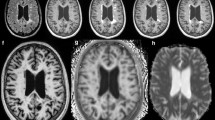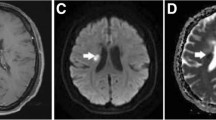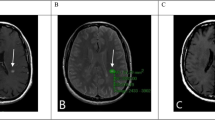Abstract
Fluid-attenuated inversion recovery (FLAIR) imaging with prolonged inversion times allows generation of highly T2-weighted images of the brain with suppression of cerebrospinal fluid signal. Such sequences result in high lesion contrast and allow visualisation of abnormalities not seen with conventional T2-weighted spin-echo sequences. We used FLAIR sequences, proton density (PD) and standard T2-weighted images to examine lesion number and distribution in ten patients with clinically definite relapsing multiple sclerosis (MS). We also studied the extent and distribution of blood-brain-barrier breakdown by gadolinium-enhanced T1-weighted images. FLAIR sequences proved feasible both in terms of acquisition time and image quality using a 0.5 T imager. FLAIR imaging allowed identification of 45 % more high-signal lesions than T2-weighted or PD images in the 10 patients. In particular, 60 % more lesions within the cortex and at the grey-white interface were identified. Cortical lesions, none of which enhanced following gadolinium-DTPA injection, were present in seven of the ten patients studied. Of all lesions identified, 8 % were cortical. FLAIR sequences are more sensitive to cortical and subcortical lesions in patients with active demyelination.
Similar content being viewed by others
References
Ormerod IEC, Miller DH, McDonald WI, et al (1987) The role of NMR imaging in the assessment of multiple sclerosis and isolated neurological lesions: a quantitative study. Brain 110: 1579–1616
De Coene B, Hajnal VJ, Pennock JM, Bydder GM (1993) MRI of the brain stem using fluid attenuated inversion recovery pulse sequences. Neuroradiology 35: 327–331
Thomas DJ, Pennock JM, Hajnal JV, Young IR, Bydder GM, Steiner RE (1993) Magnetic resonance imaging of the spinal cord in multiple sclerosis by fluid-attenuated inversion recovery. Lancet 341: 593–594
Poser CM, Paty DW, Scheinberg L, et al (1983) New diagnostic criteria for multiple sclerosis: guidelines for research protocols. Ann Neurol 13: 227–231
Hawkins CP, Munro PMG, Mackenzie F, et al (1990) Duration and selectivity of blood-brain barrier breakdown in chronic relapsing experimental allergic encephalomyelitis studied by gadolinium-DPTA and protein markers. Brain 113: 365–378
Katz D, Taubenberger JK, Cannella B, McFarlin DE, Raine CS, McFarland HF (1993) Correlation between magnetic resonance imaging findings and lesion development in chronic, active multiple sclerosis. Ann Neurol 34: 661–669
Miller DH, Rudge P, Johnson G, et al (1988) Serial gadolinium enhanced magnetic resonance imaging in multiple sclerosis. Brain 111: 927–939
Grossman RI, Gonzalez-Scarano F, Atlas SW, Galetta S, Silberberg DH (1986) Multiple sclerosis: gadolinium enhancement in MR imaging. Radiology 161: 721–725
Kappos L, Stadt D, Roharbach E, Keil W (1988) Gadolinium-DTPA enhanced MRI in the evaluation of different disease courses and disease activity in MS. Neurology 38 [Suppl 1]: 255
Brownell B, Hughes JT (1962) The distribution of plaques in the cerebrum in multiple sclerosis. J Neurol Neurosurg Psychiatry 25: 315–320
Lumsden CE (1970) The neuropathology of multiple sclerosis. In: Vinken PJ, Bruyn GW (eds) Handbook of clinical neurology, vol 9. North Holland Publishing Company, Amsterdam, pp 217–309
Revesz T, Kidd D, Thompson AJ, Barnard RO, McDonald WI (1994) A comparison of the pathology of primary and secondary progressive multiple sclerosis. Brain 117: 759–765
Newcombe J, Hawkins CP, Henderson CL, et al (1991) Histopathology of multiple sclerosis lesions detected by MRI in unfixed postmortem central nervous system tissue. Brain 114: 1013–1023
Thompson AJ, Kermode AG, MacManus DG, et al (1990) Patterns of disease activity in multiple sclerosis: clinical and MRI study. BMJ 300: 631–634
Filippi M, Miller DH, Paty DW, et al (1994) Correlation between changes in disability and MRI activity in multiple sclerosis: a follow up study. J Neurol 241 [Suppl 1]: 89
Ryberg JN, Hammond CA, Grimm RC, et al (1994) Initial clinical experience in MR imaging of the brain with a fast-FLAIR pulse sequence. Radiology 193: 173–180
Ransohoff RM, Tuohy V, Lehmann P (1994) The immunology of multiple sclerosis: new intricacies and new insights. Curr Opin Neurol 7: 242–249
Author information
Authors and Affiliations
Rights and permissions
About this article
Cite this article
Boggild, M.D., Williams, R., Haq, N. et al. Cortical plaques visualised by fluid-attenuated inversion recovery imaging in relapsing multiple sclerosis. Neuroradiology 38 (Suppl 1), S10–S13 (1996). https://doi.org/10.1007/BF02278111
Received:
Accepted:
Issue Date:
DOI: https://doi.org/10.1007/BF02278111




